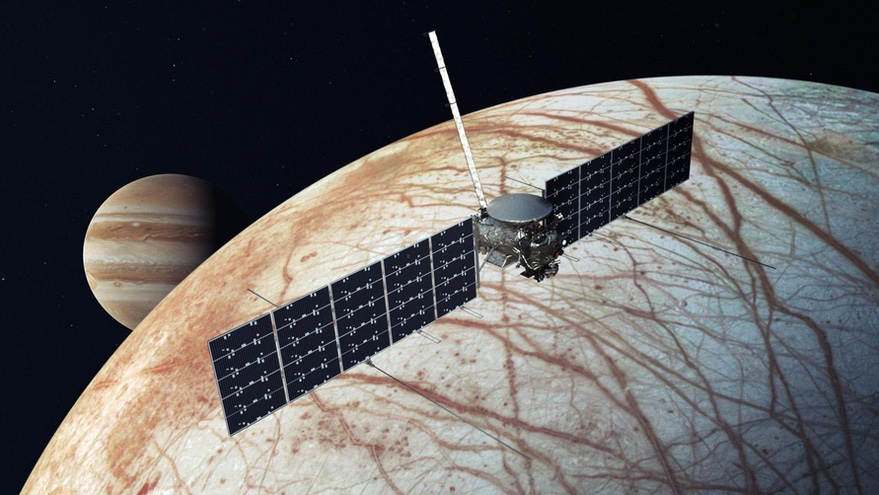WASHINGTON — NASA has selected SpaceX’s Falcon Heavy to launch its Europa Clipper mission to a potentially habitable moon of Jupiter, a choice that appeared inevitable once NASA was no longer required to use the Space Launch System.
NASA announced July 23 that it awarded a launch services contract to SpaceX for the October 2024 launch of Europa Clipper on a Falcon Heavy rocket. The contract is valued at $178 million.
The award to SpaceX was expected after Congress, in the fiscal year 2021 omnibus spending bill passed in December 2020, gave the agency the flexibility to choose an alternative launch vehicle for the mission. Previous years’ spending bills required the use of the SLS for Europa Clipper, even as NASA requested the flexibility to acquire a commercial launch vehicle.
Congress relented because of potential hardware compatibility issues found last year between Europa Clipper and SLS. The 2021 spending bill directed NASA to use SLS for Europa Clipper only if “the SLS is available and if torsional loading analysis has confirmed Clipper’s appropriateness for SLS.”
A month after the passage of the bill, NASA directed the Europa Clipper project to halt all planning for launching the spacecraft on SLS and instead prepare to use a commercial vehicle. “We now have clarity on the launch vehicle path and launch date,” Robert Pappalardo, project scientist for Europa Clipper at the Jet Propulsion Laboratory, said at a meeting in early February.
That decision made it likely NASA would select SpaceX’s Falcon Heavy given the technical requirements for the mission and the launch vehicles available to meet it. NASA placed Europa Clipper in its “Category 3” requirements for launch services, requiring that vehicles have performed at least three successful launches, including at least two successful consecutive launches.
Falcon Heavy has flown three times, all successfully, although it has not launched since June 2019. Alternative vehicles with the performance required for the mission, such as Blue Origin’s New Glenn and United Launch Alliance’s Vulcan Centaur, will not make their first launches until at least next year.
Launching Europa Clipper on Falcon Heavy, rather than SLS, results in trade-offs on both cost and schedule. NASA, in its fiscal year 2021 budget request, argued that a commercial launch could save the agency “over $1.5 billion compared to using a Space Launch System rocket.” By contrast, a NASA Office of Inspector General report in 2019 concluded the cost difference could be less than $300 million, although that study estimated the cost of a Falcon Heavy launch at $450 million, more than twice the value of the contract awarded to SpaceX.
What is not in doubt, though, is that SLS would have offered a faster ride for Europa Clipper. An SLS launch would have allowed the spacecraft to fly directly to Jupiter, arriving less than three years after launch. With Falcon Heavy, Europa Clipper will make gravity-assist flybys of Mars and Earth, arriving at Jupiter five and a half years after launch.
The Europa Clipper contract adds to a growing manifest of future Falcon Heavy missions for NASA, the Defense Department and commercial customers. That includes contracts awarded by NASA in February for the launch of the first two modules of the lunar Gateway and by Astrobotic in April for the launch of its Griffin lunar lander carrying a NASA lunar rover. The Gateway launch is currently scheduled for November 2024, just one month after the Europa Clipper launch.
Ironically, the hardware compatibility issue that finally gave NASA the flexibility to select a vehicle other than SLS to launch Europa Clipper may not have been as severe as once thought. While NASA disclosed few specifics about the problem, Steve Jurczyk, NASA acting administrator in March, said it involved higher lateral loads on the spacecraft during an SLS launch than what the spacecraft was designed for.
“Given that the design is done and some of the hardware is already manufactured, it was going to be very challenging from a cost and schedule standpoint to modify the spacecraft or develop an isolation system to handle the lateral load issue,” he said in a March interview.
However, Robert Stough of NASA’s Marshall Space Flight Center, speaking at a meeting of the steering committee of the planetary science decadal survey July 7, argued that engineers had used “very conservative” limits when doing the initial analysis. “It really was a nonissue at the end of the day,” he argued.
